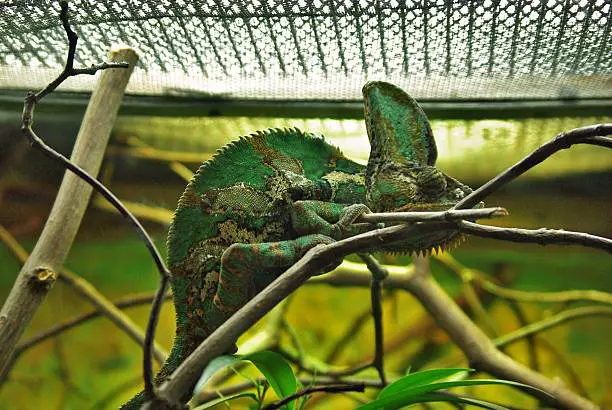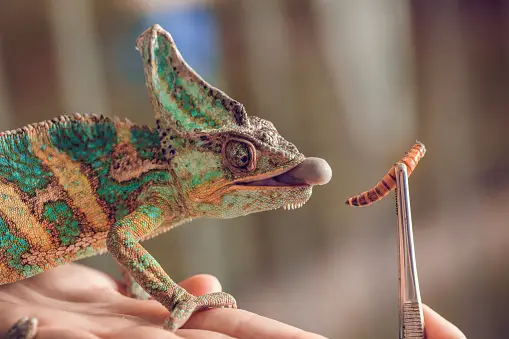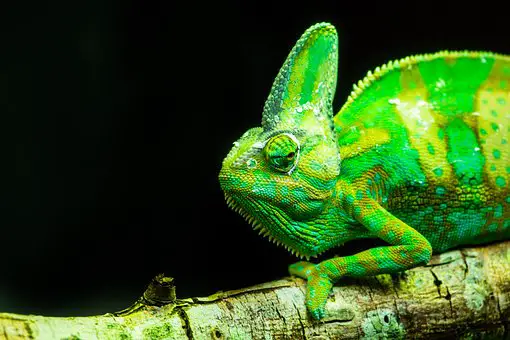Do Chameleons like to be petted? Chameleons are the most widely distributed and varied group of lizards. They are found in most parts of the world except in Antarctica, Australia, the Arctic regions of Russia, and North America. Their habitat varies from tropical rain forests to deserts and grasslands.
We have created this blog to share with the world the fantastic experience of living, petting, working with, and how chameleons react to people handling. We hope it will inspire others to try and learn more about these fascinating creatures.
The longer answer is that you have to understand that chameleons are social reptiles, just like lizards, snakes, turtles, and frogs. It would be best to pet your chameleon correctly, so the chameleon knows he is being petted and not a threat. There are many different ways to pet a chameleon, and we will discuss them here.
In this article
Petting a Chameleon: What to Do and What Not to Do
You should know a few things now about chameleons before you begin to pet them.
First, he is a very sensitive animal. He needs a lot of love and attention.
Second, he has a high metabolism. This means he needs food often, and his food can be a little expensive.
Finally, he is very active and needs to move around a lot. It would help if you had a good place for him to move around. You can buy a cage or a tank to use, but these are not necessary. A lovely garden is perfect.
Now, let’s talk about the different ways to pet your chameleon.
Cage Petting
If you want to keep your chameleon in a cage, you will need to make sure it is large enough to fit him comfortably. If you get a too-small cage, he may feel cramped and unhappy. When choosing your cage, you also want to consider the kind of environment you want your chameleon to live in. Do you want him to be in the wild? Or do you want him to stay in a more controlled environment? If you want your chameleon to stay in a controlled environment, you should consider getting a large cage.

However, if you will be taking your chameleon out of the cage, make sure you don’t leave him alone for too long. If he isn’t used to being out of his cage, he may panic and not know what to do. You can also use this time to socialize with him by introducing him to other chameleons. When you first bring your chameleon into his new cage, you will want to give him some time to adjust to his new surroundings. It might take him a few days to get used to being in a cage. He may look around and not understand why he is confined.
Once your chameleon is used to his new surroundings, you can slowly introduce him to being out of his cage. You can let him out for short periods or gradually increase the amount of time he is out of his cage. If you are looking to keep your chameleon in the wild, you should have a large enclosure for him to live in. This will allow him to run around freely, climb on things, and do all of the things he would do in the wild. If you don’t have room for a large enclosure, you can use a small one instead. However, your enclosure must be secure enough to keep your chameleon safe from predators.
Cage Care
If you keep your chameleon in a cage, keeping the environment clean and well-ventilated is essential. You should also ensure that your chameleon’s water bowl is cleaned at least once a week.
Hand Petting

When you first bring your chameleon home, you will want to pet him to make sure he is used to being handled. To do this, gently pick him up with your hands. Hold him for a few minutes, and then put him back down. Do this a few times over a few days until he is comfortable picking up and handling. Once your chameleon is used to being handled, you can start petting him more often. You can use your fingers or a soft brush to stroke his body. Make sure you never use any rough materials, such as fur brushes or clothes brushes. This could cause harm to your chameleon.
To prevent your chameleon from getting sunburned, always cover the chameleon’s skin with a thin layer of sunscreen when you are outdoors. If you are not around a window or have a shady area to keep the chameleon in, you can even place the chameleon in a covered box. You will want to make sure you do these several hours before you leave so that the chameleon has time to acclimate to the heat.
How To Tell If Your Chameleon Is Uncomfortable
A chameleon’s skin changes colors and patterns to blend into its surroundings. But just like your chameleon, you should detect when it is not comfortable in the environment.
You don’t want to have to put your chameleon in a new home if it doesn’t feel right. The same thing goes for your chameleon.
If your chameleon is uncomfortable, it may be displaying some signs that you should pay attention to. Here are some possible symptoms of discomfort your chameleon could be experiencing. When your chameleon is comfortable, it will generally not display any of these signs. However, if you notice any of them, you might want to take action.
Possible symptoms of Discomfort Your Chameleon
- The chameleon will not sit on its perch. Instead, it will remain in the enclosure and may even spend time lying down.
- Your chameleon will not groom itself. It will just look dirty or unkempt.
- Your chameleon will not eat. Instead, it may simply stare at you with a vacant expression.
- Chameleons only puff up when they’re trying to hide from predators, so it’s best not to disturb them when they’re in that mode.
- When your chameleon growls or hisses, he’s warning you that he’s not happy with your presence. If you don’t mind him keeping his distance, then you can watch him from afar.
- When your chameleon feels upset, they may hide, run away, or attack. They have the right to do this.
- Chameleons might change their color, becoming darker in color to indicate that they’re in a bad mood or comfortableness.
- Your chameleon’s eyes may be red or swollen.
- When moving around, your chameleon may be very slow.
- Your chameleon may not respond to your calls.
- The Skin of your chameleon may become very dry.
- Your chameleon may not drink water.
- Breathing may be observed to be difficult for your chameleon.
- Your chameleon may not urinate or defecate.
How To Help Your Chameleon Be More Comfortable
We know that a chameleon’s environment affects their comfort level. We’ve created a list of the best tips and tricks to help your chameleon be happier and more comfortable in their cage or surrounding.
The Cage or Surrounding:
The size of the cage is critical. When choosing the right size for your chameleon, you’ll need to make sure there are enough branches, leaves, and other objects to provide a natural environment for your chameleon. Also, make sure that the cage has enough space for your chameleon to move around and stretch its limbs.
A good cage should have a suitable substrate. This can be bought at an online store or at pet stores. You’ll want to choose a substrate that is easy to clean, doesn’t smell, is made from wood or plastic, and provides plenty of places for your chameleon to hide.
Cage Maintenance:
Your chameleon will need to be cleaned every two weeks, depending on how dirty it is. If you have a lot of dead insects and debris in the cage, you’ll want to clean it more often. If there is only a little dirt and debris, you may only need to clean it once a month. There are several different types of cages. You can get a simple plastic cage or a wire or plastic one. You’ll also want to ensure that you’re not using any glue or tape on the cage because this can affect your chameleon’s health.
The Food:

Choose food that’s appropriate for your chameleon’s size and age. You should also choose a portion of food with protein, calcium, vitamin C, and vitamin D. You can buy this online or at pet stores. Make sure that you feed your chameleon at least twice a day. This way, your chameleon will have enough time to digest and absorb the food.
Water:
You’ll want to make sure that your chameleon has access to freshwater. You should also make sure that the water is clean and has no dirt or debris.
Sunlight:
Your chameleon should be exposed to sunlight for about 15 minutes every day. You can buy a lightbox for this purpose. If your chameleon does not like being outside, then you can keep him in a cage with a window.
Bugs:
You should keep your chameleon away from spiders and other bugs. You should also make sure that there are no mosquitoes or ants around. If you do not know how to avoid these things, you can get help from an animal expert.
Conclusion
A chameleon’s personality and personality changes are all about mood. If you don’t approach your chameleon slowly and gently, it will be frightened and will try to escape, which is why it is vital to get them used to you and their new home before you start playing with them.

